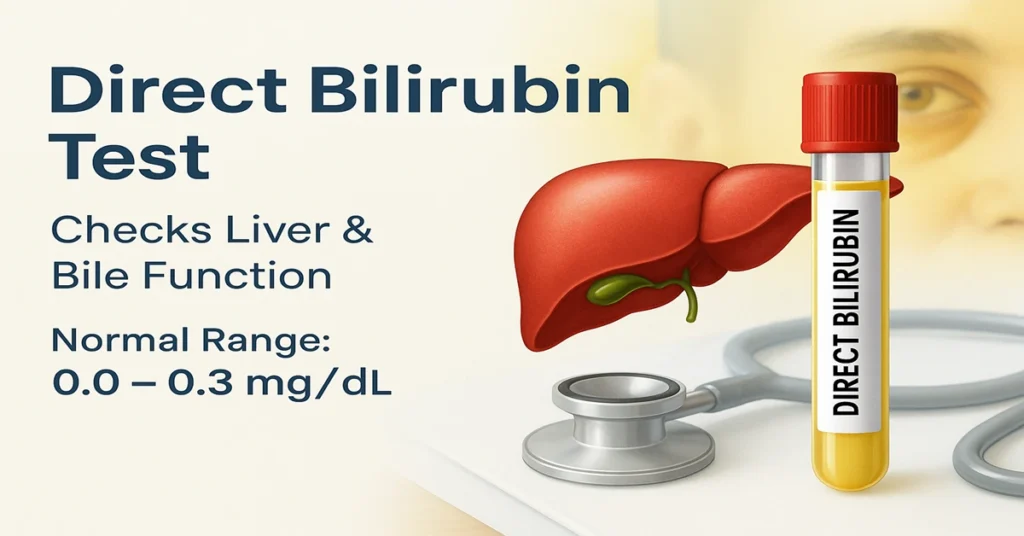What is Direct Bilirubin?
Direct bilirubin, also called conjugated bilirubin, is the form of bilirubin that has been processed by the liver. In this process, the liver attaches a substance called glucuronic acid, which makes bilirubin water-soluble.
This form of bilirubin is a part of total bilirubin measured in blood tests and represents the portion that is ready to be excreted into bile and removed from the body. Doctors often measure direct bilirubin to check liver health and bile flow.
Where is it Synthesized/Produced in the Body?
- Direct bilirubin is produced in the liver.
- Old red blood cells (RBCs) break down in the spleen and bone marrow, forming unconjugated (indirect) bilirubin.
- This unconjugated bilirubin travels to the liver, where liver cells (hepatocytes) convert it into direct (conjugated) bilirubin through a process called glucuronidation.
- Being water-soluble, direct bilirubin is then sent into bile, which flows into the intestine and leaves the body in stool.
Main Functions and Importance
Even though bilirubin itself is a waste product, direct bilirubin plays an important role in health diagnosis:
- Indicator of liver function: High levels may signal liver or bile duct problems.
- Excretion marker: Shows that bilirubin is being processed and prepared for removal.
- Diagnostic tool: Helps in detecting conditions like obstructive jaundice, liver diseases, and bile duct disorders.
Causes of Low Direct Bilirubin
Low levels are usually not a medical concern. They may be seen in:
- People with naturally low total bilirubin
- Overhydration or mild laboratory variations
- Generally, low direct bilirubin has no clinical significance
Causes of High Direct Bilirubin
High direct bilirubin (conjugated hyperbilirubinemia) may happen due to:
- Obstruction of bile ducts (gallstones, tumors)
- Hepatitis or liver injury
- Cholestasis (blockage of bile flow)
- Liver cirrhosis (long-term liver damage)
- Dubin-Johnson syndrome (rare inherited condition)
- Biliary atresia in newborns (bile ducts absent or blocked)
- Liver cancers or metastasis
Symptoms of High Direct Bilirubin
- Yellowing of skin and eyes (jaundice)
- Dark-colored urine
- Pale or clay-colored stools
- Itching (pruritus)
- Fatigue, abdominal discomfort, or pain (in liver-related cases)
Reference Ranges
- Direct (Conjugated) Bilirubin: 0.0 – 0.3 mg/dL
(Ranges may slightly vary depending on the lab) - Normally, direct bilirubin forms about 15–30% of total bilirubin.
Sample Type
- Sample Type: Serum
- Tube Used: Red Top (Plain Tube)
Test Preparation
- Usually, no special preparation is required.
- In some cases, fasting for 4–6 hours may be recommended (follow doctor’s advice).
- Avoid alcohol before the test as it can affect liver function.
- Inform your doctor about medications (antibiotics, anti-seizure drugs, oral contraceptives) as they can impact bilirubin levels.
When to Consult a Doctor
You should consult a doctor if you experience:
- Yellowing of eyes or skin (jaundice)
- Persistent fatigue or loss of appetite
- Dark urine and pale stools
- Itching without clear cause
- Abdominal swelling or pain
- Unexplained weight loss (if linked to liver or bile duct issues)
Important Word Explanations
- Bilirubin: A yellow pigment formed from red blood cell breakdown.
- Conjugated Bilirubin: Water-soluble bilirubin processed by the liver.
- Unconjugated Bilirubin: Fat-soluble form, not yet processed by the liver.
- Glucuronidation: The liver’s process of making bilirubin water-soluble.
- Cholestasis: Blockage or slowing down of bile flow.
~END~

